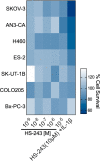A highly selective inhibitor of interleukin-1 receptor-associated kinases 1/4 (IRAK-1/4) delineates the distinct signaling roles of IRAK-1/4 and the TAK1 kinase
- PMID: 31914413
- PMCID: PMC7008364
- DOI: 10.1074/jbc.RA119.011857
A highly selective inhibitor of interleukin-1 receptor-associated kinases 1/4 (IRAK-1/4) delineates the distinct signaling roles of IRAK-1/4 and the TAK1 kinase
Abstract
Interleukin-1 receptor-associated kinase-1 (IRAK-1) and IRAK-4, as well as transforming growth factor β-activated kinase 1 (TAK1), are protein kinases essential for transducing inflammatory signals from interleukin receptors. IRAK family proteins and TAK1 have high sequence identity within the ATP-binding pocket, limiting the development of highly selective IRAK-1/4 or TAK1 inhibitors. Beyond kinase activity, IRAKs and TAK1 act as molecular scaffolds along with other signaling proteins, complicating the interpretation of experiments involving knockin or knockout approaches. In contrast, pharmacological manipulation offers the promise of targeting catalysis-mediated signaling without grossly disrupting the cellular architecture. Recently, we reported the discovery of takinib, a potent and highly selective TAK1 inhibitor that has only marginal activity against IRAK-4. On the basis of the TAK1-takinib complex structure and the structure of IRAK-1/4, here we defined critical contact sites of the takinib scaffold within the nucleotide-binding sites of each respective kinase. Kinase activity testing of takinib analogs against IRAK-4 identified a highly potent IRAK-4 inhibitor (HS-243). In a kinome-wide screen of 468 protein kinases, HS-243 had exquisite selectivity toward both IRAK-1 (IC50 = 24 nm) and IRAK-4 (IC50 = 20 nm), with only minimal TAK1-inhibiting activity (IC50 = 0.5 μm). Using HS-243 and takinib, we evaluated the consequences of cytokine/chemokine responses after selective inhibition of IRAK-1/4 or TAK1 in response to lipopolysaccharide challenge in human rheumatoid arthritis fibroblast-like synoviocytes. Our results indicate that HS-243 specifically inhibits intracellular IRAKs without TAK1 inhibition and that these kinases have distinct, nonredundant signaling roles.
Keywords: autoimmune disease; immunology; inhibitor; interleukin; tumor necrosis factor (TNF).
© 2020 Scarneo et al.
Conflict of interest statement
T. A. J. H., S. A. S., and P. F. H. are part owners of EydisBio (Durham, NC), which options the takinib patent from Duke University
Figures








References
-
- Feldmann M., Brennan F. M., Elliott M., Katsikis P., and Maini R. N. (1994) TNFα as a therapeutic target in rheumatoid arthritis. Circ. Shock 43, 179–184 - PubMed
-
- Elliott M. J., Maini R. N., Feldmann M., Long-Fox A., Charles P., Katsikis P., Brennan F. M., Walker J., Bijl H., and Ghrayeb J. (1993) Treatment of rheumatoid arthritis with chimeric monoclonal antibodies to tumor necrosis factor α. Arthritis Rheum. 36, 1681–1690 10.1002/art.1780361206 - DOI - PubMed
-
- Boyle D. L., Soma K., Hodge J., Kavanaugh A., Mandel D., Mease P., Shurmur R., Singhal A. K., Wei N., Rosengren S., Kaplan I., Krishnaswami S., Luo Z., Bradley J., and Firestein G. S. (2015) The JAK inhibitor tofacitinib suppresses synovial JAK1-STAT signalling in rheumatoid arthritis. Ann. Rheum. Dis. 74, 1311–1316 10.1136/annrheumdis-2014-206028 - DOI - PMC - PubMed
Publication types
MeSH terms
Substances
Associated data
- Actions
- Actions
Grants and funding
LinkOut - more resources
Full Text Sources
Other Literature Sources
Miscellaneous

